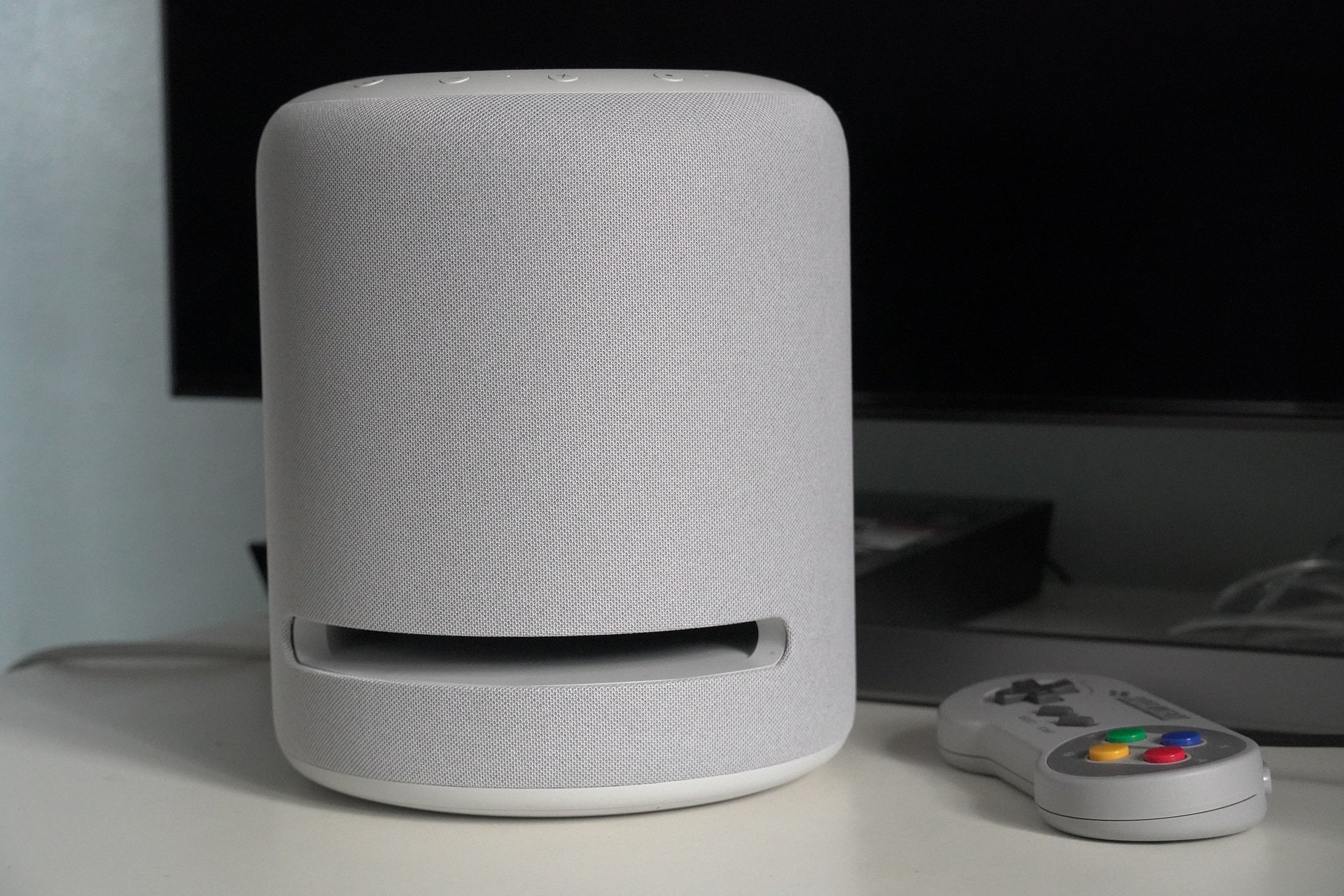Verdict
A few tweaks haven’t (for better or worse) changed the overall sonic character of the Echo Studio, which remains a fun, energetic listen, and the best-sounding Echo speaker available. The new spatial audio feature doesn’t always have the best effect on music though, while the hike in price to over £200 may cool people’s interest despite its support for 3D audio.
Pros
- 3D and Hi-res audio support
- Speedy Alexa performance
- Big, spacious sound
- Powerful bass
Cons
- More expensive after price hike
- High frequency performance could be brighter
- Works best in the Amazon ecosystem
- Spatial processing can thin out music
Availability
- UKRRP: £219.99
- USARRP: $199.99
- EuropeRRP: €239.99
- CanadaRRP: CA$259.99
- Australiaunavailable
-
Stereo Spatial EnhancementProduces a hi-fi like sound with spatial processing -
3D audioSupports Dolby Atmos, MPEH-H and 360 Reality Audio
Introduction
The original Echo Studio launched in 2019 as Amazon’s choice to spearhead its assault on the wireless speaker market.
Its Echo range of wireless speakers placed an emphasis on smarts over fidelity, but the Echo Studio saw Amazon build a powerhouse of a speaker with support for Dolby Atmos and Hi-res audio at a relatively affordable price.
And as it’s connected to the Internet, the Echo Studio can be updated at any time, so in 2022, Amazon tweaked the speaker’s spatial audio processing and frequency range.
Rather than ‘update’ our previous review, we’ve written a new one as the changes and new price seem substantial enough to warrant another take. Is Amazon’s premier wireless speaker better or worse with these changes?
Design
- No change in overall appearance
- New Glacier White variant
- No ethernet port
Nothing has been altered with the speaker’s exterior appearance aside from being available in a Glacial White finish. The Echo Studio has always resembled the look of Iron Man’s head in its Mk I suit, and this makes it even clearer.
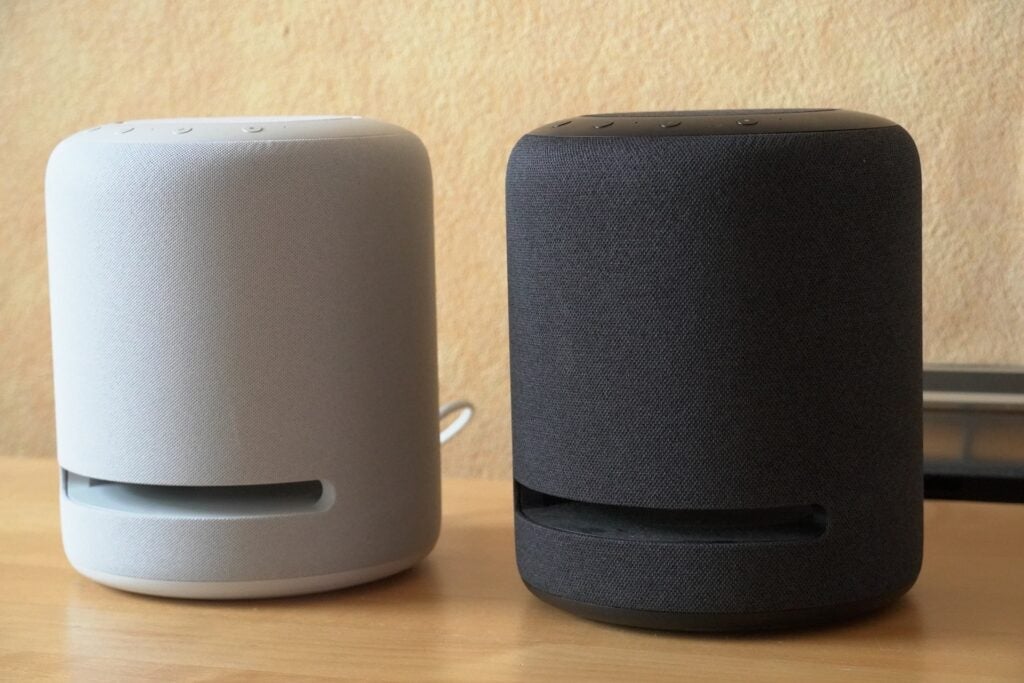
It’s the same size at 206mm tall and 175mm wide, and weight at 3.5kg. The Echo Studio is a heavy speaker with a footprint bigger than either the original HomePod or the HomePod 2 so it’ll need firm support to sit on.
The aperture towards the base of the speaker maximises the bass output, and if you peek through at the right angle, you’ll see the woofer vibrating. The speaker is covered in a scratch-resistant fabric looking (safe from prying household pets), and the white version brings with it the option of placing the speaker in a room with more neutral or brighter colours.
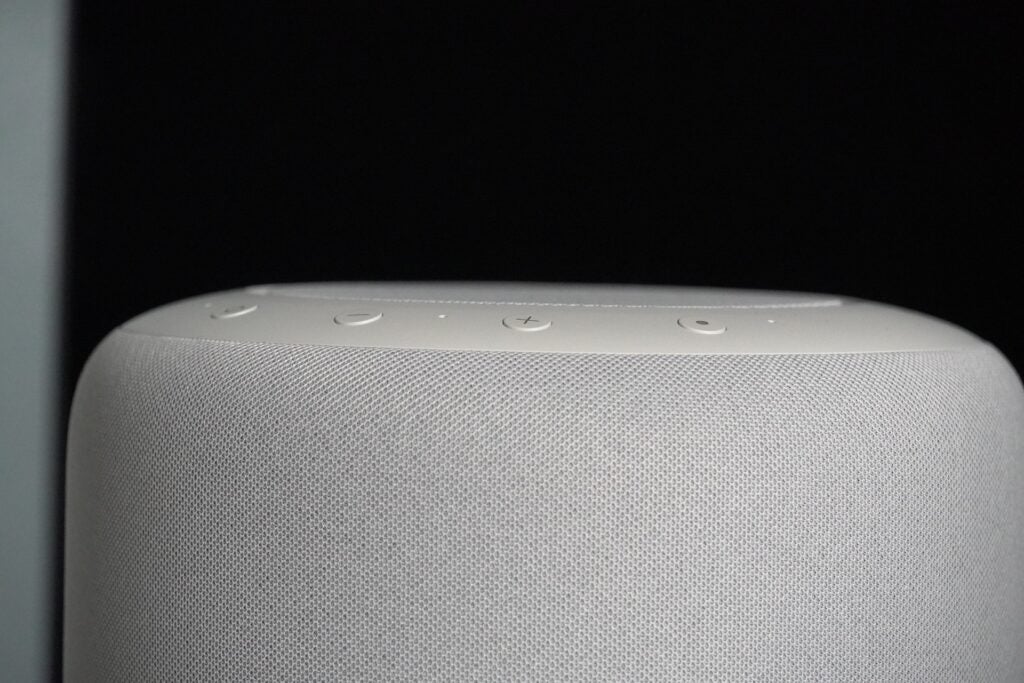
Around the top of the speaker are four buttons, one for turning the built-in microphones off for privacy reasons, plus buttons for volume, and an ‘Action’ button to call up Alexa and encircling the speaker’s inner section is the ubiquitous Alexa light ring. There’s no remote provided but if you have a Fire TV device the speaker can be paired for operation and the Alexa remote used for control.
There’s the capacity to hook the Echo Studio to another source through the 3.5mm/mini optical line-in but there isn’t an ethernet port, so you’re reliant on Wi-Fi for an internet connection.
Features
- Auto room calibration
- Zigbee smart hub built-in
- Wide audio support
Like Sonos’ Auto Trueplay or Apple’s HomePod, the Echo Studio can automatically calibrate its performance by analysing the area it’s in. Unlike the HomePod, it’ll only run this procedure when it’s turned off and on at the plug, the Alexa light ring pulses at start-up for thirty seconds to a minute as it optimises.
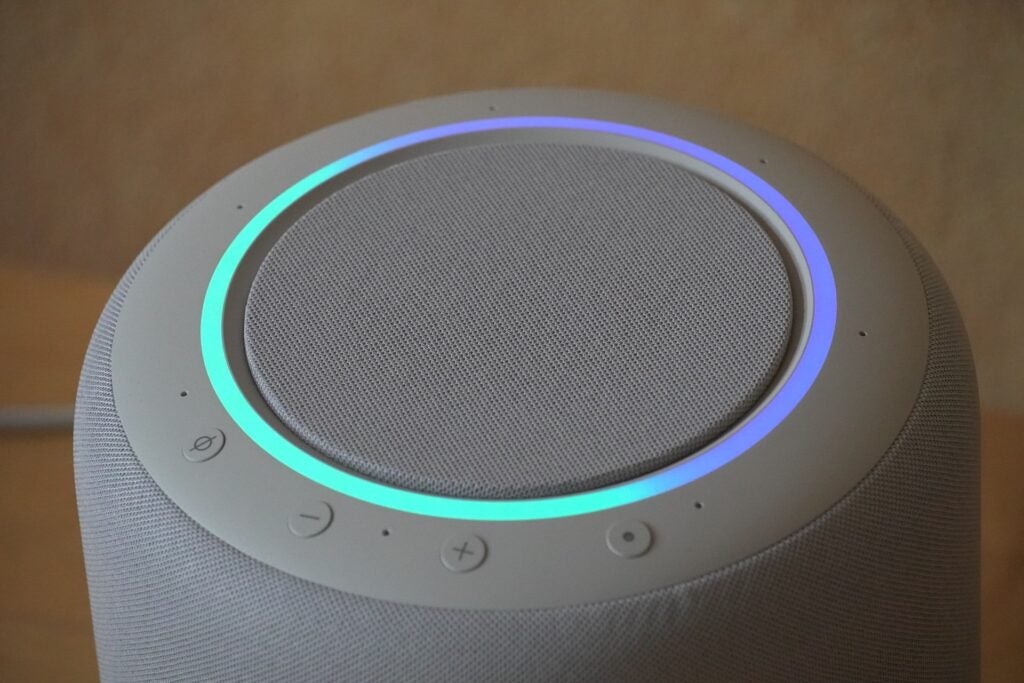
Initial set-up is through the Alexa app which takes a few minutes to get the speaker up to speed. The app includes Alexa routines, connecting to other Amazon devices and services, as well as linking to music streaming services, though in the UK this only extends to Amazon Music, Apple Music, Deezer and Spotify (and only Spotify Premium supports Alexa voice).
As a smart speaker the Echo Studio features Zigbee built-in and can communicate and control other devices through Alexa. Provision for the Matter home smart standard has also been added.
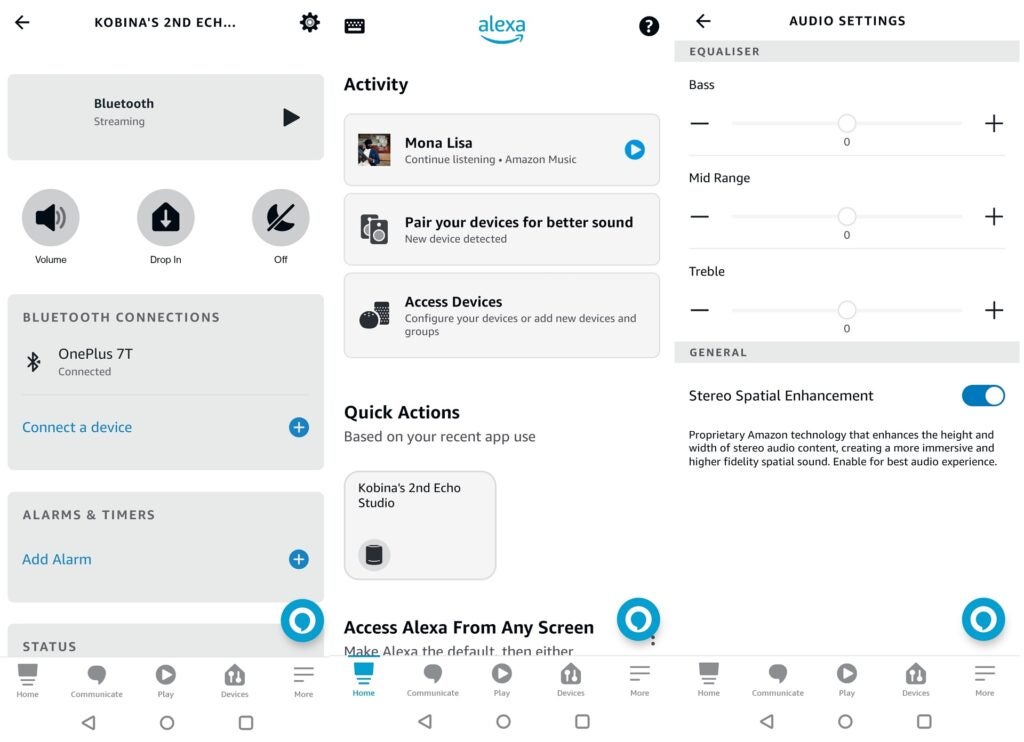
Purchase a pair of Echo Studios and they can be used in a stereo set-up, while an Echo Sub takes care of the bass. If you have a Fire TV Cube, there’s also the option of creating a Dolby Atmos-compatible home cinema system.
As well as Wi-Fi connectivity there’s Bluetooth support, though Amazon’s never stated which version, and there is no room for Tidal Connect or Chromecast. File support includes FLAC, MP3, AAC, Opus, Vorbis for music streaming, Dolby Digital, Dolby Digital Plus and Dolby Atmos, while Sony 360 Reality Audio and MPEG-H for 3D audio.
The Echo Studio can, according to Amazon, play tracks up to 24-bit/44.1kHz, but the Music app can be vague in informing the resolution you are listening at, with no information available when casting over Wi-Fi, though more info is provided over a Bluetooth connection. It’s a puzzling situation.
Sound Quality
- Weighty bass performance
- Treble could benefit from more sparkle
- Dolby Atmos performance
In 2022 Amazon released an OTA (over-the-air) update that added new spatial audio processing technology and extended the frequency range. The former is said to help enhance stereo sound with “greater width, clarity and presence” to mirror the performance of a hi-fi system.
With the latter Amazon claims to have improved mid-range clarity and bass extension. As it’s an update, it’s freely available across all Echo Studios, so regardless of whether you bought one in 2019 or 2023, they all sound the same.
That makes it harder to compare the sound of the 2019 model to the 2022, though looking through my notes, the differences are minor rather than major.
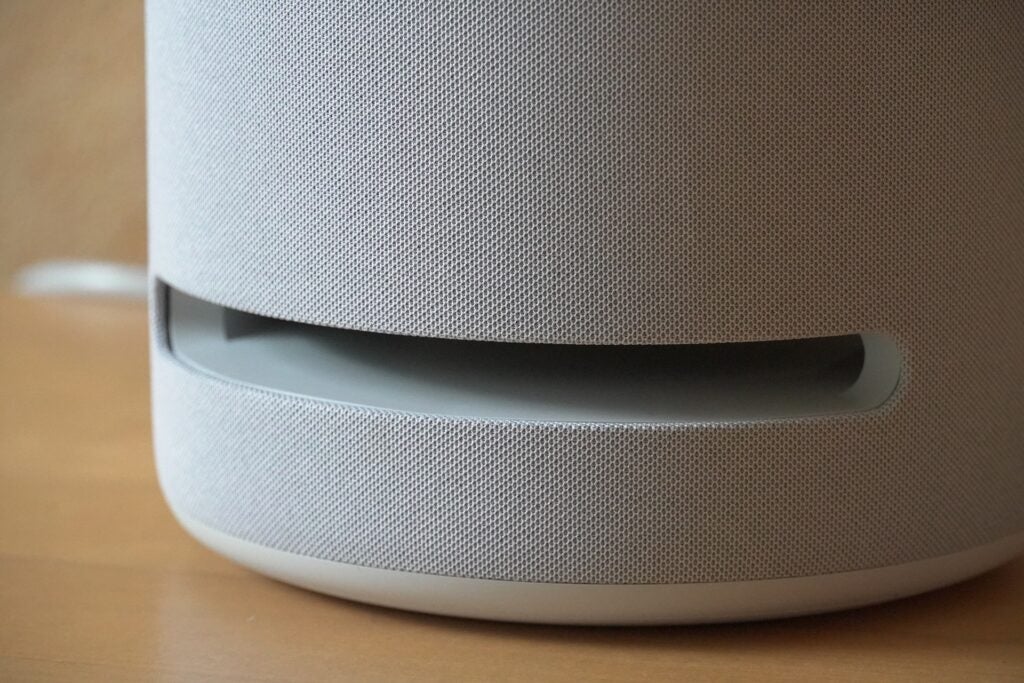
Bass seems to have been tempered somewhat but can still go very deep, midrange clarity remains good, especially with voices and treble is treated with clarity in GoGo Penguin’s Erased by Sunlight though it could benefit from more brightness and tonal variation.
With Amazon’s spatial audio technology, I’ll say that it’s both interesting and a little odd. There’s an increased sense of depth and width that expands stereo music beyond the speaker’s form, but with that expansion comes a thinner presentation and lesser sense of definition. Higher frequencies seem most affected by turning on the Stereo Spatial Engagement feature, giving them a hollow ring. I should mention it’s not activated for tracks that already support 3D audio.
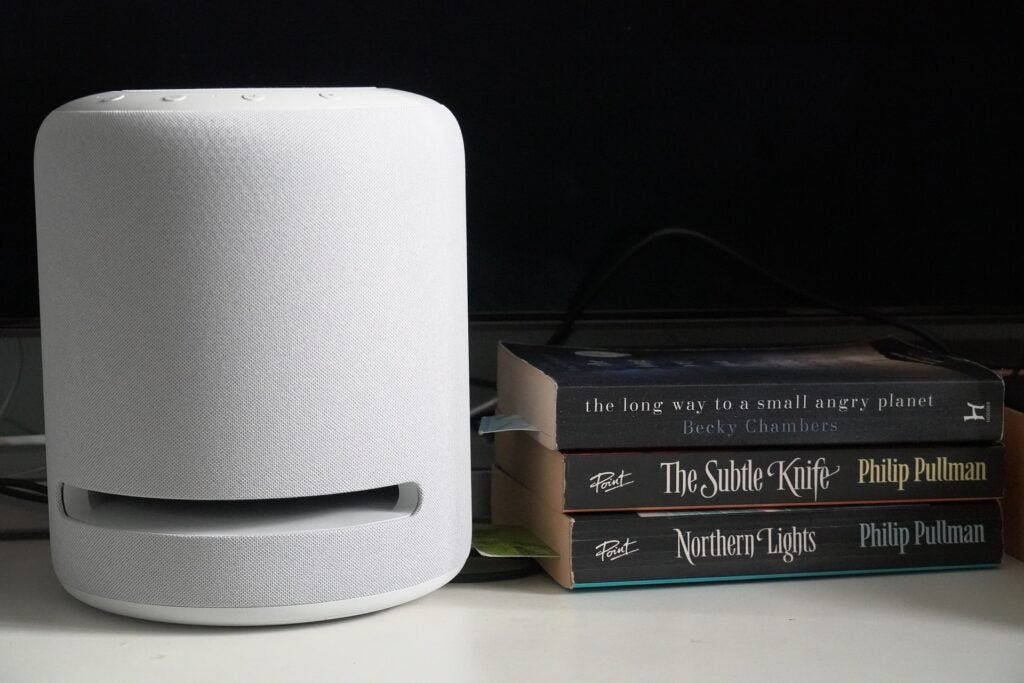
Vocals are presented front and centre, and there are suitable amounts of clarity and detail to bring out the inflections of Faye Webster’s I Know I’m Funny Haha or Chris Cornell’s Black Hole Sun. Tonally the speaker errs towards a more even tonal balance but hasn’t lost its sense of energy, momentum, or dynamism for what remains a lively performance.
Bass is powerful – there is no speaker in its price bracket that can rival it in those terms, and the low frequency performance feels less hyperactive compared to the ‘original’ sound. There’s a proper thud to Faye Webster’s Better Distractions, while Sza’s Shirt in Atmos has bass that explodes from the speaker and rumbles through the surface it is on. I think some will still find the bass performance too powerful, but with Rihanna’s S&M it doesn’t dominate as much as I remember.
With Atmos the performance depends on how the track was mixed, and possibly an issue with the Echo Studio is that its levels of definition aren’t enough to bring out the best of most songs but with the right track it can be spectacular. Pink Floyd’s Money shows an amazing reach in terms of height, the sound of the cash register is well above the speaker. Like the Era 300, Dolby Atmos music is notable by sounding bigger, wider and featuring more depth.
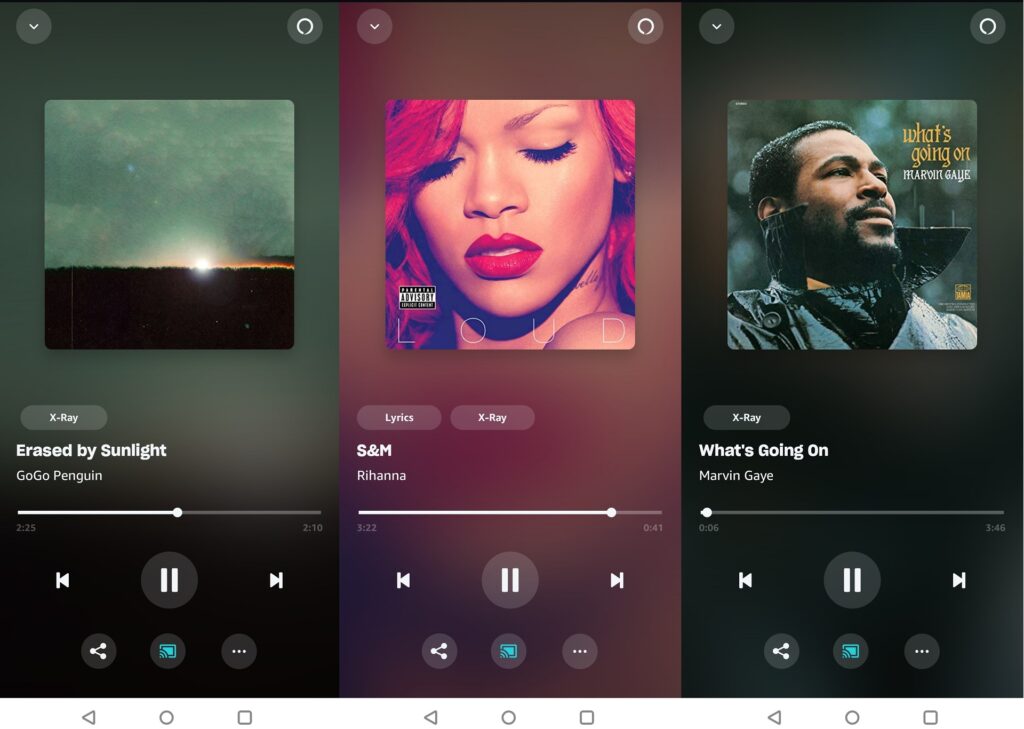
The Echo Studio doesn’t carry the same levels of clarity as the more expensive Sonos Era 300; the Sonos delivers better depth and definition with Atmos tracks – the guitar at the beginning of Blondie’s Call Me is better defined on the Era 300 – and with tracks such as Marvin Gaye’s What’s Going On and Gregory Porter’s Mona Lisa there’s clearer separation between the various elements of the track than the Echo Studio can muster.
Switch to Bluetooth and the volume must be pumped to get a similar level of energy and scale, but detail and definition levels aren’t as good as casting over Wi-Fi.
Latest deals
Should you buy it?
It’s still the most affordable Atmos speaker: Despite the price hike, the Echo Studio is cheaper than the competition, and puts out a confident 3D audio performance.
It’s still not quite the most fidelious speaker: Some will find the bass overwrought, but I find the higher end a little lacking in sparkle. 3D audio differentiates this speaker from the rest of its price alternatives, but the competition is better in some respects.
Final Thoughts
While it’s hard to be definitive about how much of an effect these tweaks have had compared to the original Echo Studio’s sound, it remains the best-sounding Echo speaker on the market.
Its support for 3D audio differentiates it from other speakers in its orbit, and if you like bass you’ll enjoy the Echo Studio’s propensity for giving tracks plenty of welly, though your neighbours may not be as forgiving. There are areas for improvement: high frequencies could benefit from more brightness while the addition of the Stereo Spatial Enhancement feature has its plusses and minuses.
The Echo Studio has also gone up in price. If you’re not interested in 3D audio and the surcharge that comes with getting access to it, there are plenty of alternatives such as the Sonos One, Era 100 and Denon Home 150.
How we test
We test every wireless speaker we review thoroughly over an extended period of time. We use industry standard tests to compare features properly. We’ll always tell you what we find. We never, ever, accept money to review a product.
Find out more about how we test in our ethics policy.
Tested with real world use
FAQs
To listen to Atmos music on the Echo Studio, you’ll need access to the Amazon Music Unlimited service and the you can play any music with the Dolby Atmos badge on it.
Sustainability
Trusted Reviews’ holds the fact that global warming is not a myth as a core value and will continuously endeavour to help protect our planet from harm in its business practices.
As part of this mission, whenever we review a product we send the company a series of questions to help us gauge and make transparent the impact the device has on the environment.
We currently haven’t received answers to the questions on this product, but will update this page the moment we do. You can see a detailed breakdown of the questions we ask and why in our sustainability info page.
Jargon buster
Dolby Atmos
Dolby Atmos is an object-based audio format. It expands on 5.1 and 7.1 soundtracks by adding overhead channels. Sounds are referred to as “audio objects”, of which there can be up to 128 audio channels, and these ‘objects’ can be accurately positioned within a 3D soundscape. This allows soundtracks that support the technology to place sounds above and around the listener with compatible kit.
Hi-Res Audio
Hi-Res audio is referred to as a standard as well as a marketing term that describes digital audio files of better-than-CD quality (16-bit/44.1kHz).
Verdict
A few tweaks haven’t (for better or worse) changed the overall sonic character of the Echo Studio, which remains a fun, energetic listen, and the best-sounding Echo speaker available. The new spatial audio feature doesn’t always have the best effect on music though, while the hike in price to over £200 may cool people’s interest despite its support for 3D audio.
Pros
- 3D and Hi-res audio support
- Speedy Alexa performance
- Big, spacious sound
- Powerful bass
Cons
- More expensive after price hike
- High frequency performance could be brighter
- Works best in the Amazon ecosystem
- Spatial processing can thin out music
Availability
- UKRRP: £219.99
- USARRP: $199.99
- EuropeRRP: €239.99
- CanadaRRP: CA$259.99
- Australiaunavailable
-
Stereo Spatial EnhancementProduces a hi-fi like sound with spatial processing -
3D audioSupports Dolby Atmos, MPEH-H and 360 Reality Audio
Introduction
The original Echo Studio launched in 2019 as Amazon’s choice to spearhead its assault on the wireless speaker market.
Its Echo range of wireless speakers placed an emphasis on smarts over fidelity, but the Echo Studio saw Amazon build a powerhouse of a speaker with support for Dolby Atmos and Hi-res audio at a relatively affordable price.
And as it’s connected to the Internet, the Echo Studio can be updated at any time, so in 2022, Amazon tweaked the speaker’s spatial audio processing and frequency range.
Rather than ‘update’ our previous review, we’ve written a new one as the changes and new price seem substantial enough to warrant another take. Is Amazon’s premier wireless speaker better or worse with these changes?
Design
- No change in overall appearance
- New Glacier White variant
- No ethernet port
Nothing has been altered with the speaker’s exterior appearance aside from being available in a Glacial White finish. The Echo Studio has always resembled the look of Iron Man’s head in its Mk I suit, and this makes it even clearer.

It’s the same size at 206mm tall and 175mm wide, and weight at 3.5kg. The Echo Studio is a heavy speaker with a footprint bigger than either the original HomePod or the HomePod 2 so it’ll need firm support to sit on.
The aperture towards the base of the speaker maximises the bass output, and if you peek through at the right angle, you’ll see the woofer vibrating. The speaker is covered in a scratch-resistant fabric looking (safe from prying household pets), and the white version brings with it the option of placing the speaker in a room with more neutral or brighter colours.

Around the top of the speaker are four buttons, one for turning the built-in microphones off for privacy reasons, plus buttons for volume, and an ‘Action’ button to call up Alexa and encircling the speaker’s inner section is the ubiquitous Alexa light ring. There’s no remote provided but if you have a Fire TV device the speaker can be paired for operation and the Alexa remote used for control.
There’s the capacity to hook the Echo Studio to another source through the 3.5mm/mini optical line-in but there isn’t an ethernet port, so you’re reliant on Wi-Fi for an internet connection.
Features
- Auto room calibration
- Zigbee smart hub built-in
- Wide audio support
Like Sonos’ Auto Trueplay or Apple’s HomePod, the Echo Studio can automatically calibrate its performance by analysing the area it’s in. Unlike the HomePod, it’ll only run this procedure when it’s turned off and on at the plug, the Alexa light ring pulses at start-up for thirty seconds to a minute as it optimises.

Initial set-up is through the Alexa app which takes a few minutes to get the speaker up to speed. The app includes Alexa routines, connecting to other Amazon devices and services, as well as linking to music streaming services, though in the UK this only extends to Amazon Music, Apple Music, Deezer and Spotify (and only Spotify Premium supports Alexa voice).
As a smart speaker the Echo Studio features Zigbee built-in and can communicate and control other devices through Alexa. Provision for the Matter home smart standard has also been added.

Purchase a pair of Echo Studios and they can be used in a stereo set-up, while an Echo Sub takes care of the bass. If you have a Fire TV Cube, there’s also the option of creating a Dolby Atmos-compatible home cinema system.
As well as Wi-Fi connectivity there’s Bluetooth support, though Amazon’s never stated which version, and there is no room for Tidal Connect or Chromecast. File support includes FLAC, MP3, AAC, Opus, Vorbis for music streaming, Dolby Digital, Dolby Digital Plus and Dolby Atmos, while Sony 360 Reality Audio and MPEG-H for 3D audio.
The Echo Studio can, according to Amazon, play tracks up to 24-bit/44.1kHz, but the Music app can be vague in informing the resolution you are listening at, with no information available when casting over Wi-Fi, though more info is provided over a Bluetooth connection. It’s a puzzling situation.
Sound Quality
- Weighty bass performance
- Treble could benefit from more sparkle
- Dolby Atmos performance
In 2022 Amazon released an OTA (over-the-air) update that added new spatial audio processing technology and extended the frequency range. The former is said to help enhance stereo sound with “greater width, clarity and presence” to mirror the performance of a hi-fi system.
With the latter Amazon claims to have improved mid-range clarity and bass extension. As it’s an update, it’s freely available across all Echo Studios, so regardless of whether you bought one in 2019 or 2023, they all sound the same.
That makes it harder to compare the sound of the 2019 model to the 2022, though looking through my notes, the differences are minor rather than major.

Bass seems to have been tempered somewhat but can still go very deep, midrange clarity remains good, especially with voices and treble is treated with clarity in GoGo Penguin’s Erased by Sunlight though it could benefit from more brightness and tonal variation.
With Amazon’s spatial audio technology, I’ll say that it’s both interesting and a little odd. There’s an increased sense of depth and width that expands stereo music beyond the speaker’s form, but with that expansion comes a thinner presentation and lesser sense of definition. Higher frequencies seem most affected by turning on the Stereo Spatial Engagement feature, giving them a hollow ring. I should mention it’s not activated for tracks that already support 3D audio.

Vocals are presented front and centre, and there are suitable amounts of clarity and detail to bring out the inflections of Faye Webster’s I Know I’m Funny Haha or Chris Cornell’s Black Hole Sun. Tonally the speaker errs towards a more even tonal balance but hasn’t lost its sense of energy, momentum, or dynamism for what remains a lively performance.
Bass is powerful – there is no speaker in its price bracket that can rival it in those terms, and the low frequency performance feels less hyperactive compared to the ‘original’ sound. There’s a proper thud to Faye Webster’s Better Distractions, while Sza’s Shirt in Atmos has bass that explodes from the speaker and rumbles through the surface it is on. I think some will still find the bass performance too powerful, but with Rihanna’s S&M it doesn’t dominate as much as I remember.
With Atmos the performance depends on how the track was mixed, and possibly an issue with the Echo Studio is that its levels of definition aren’t enough to bring out the best of most songs but with the right track it can be spectacular. Pink Floyd’s Money shows an amazing reach in terms of height, the sound of the cash register is well above the speaker. Like the Era 300, Dolby Atmos music is notable by sounding bigger, wider and featuring more depth.

The Echo Studio doesn’t carry the same levels of clarity as the more expensive Sonos Era 300; the Sonos delivers better depth and definition with Atmos tracks – the guitar at the beginning of Blondie’s Call Me is better defined on the Era 300 – and with tracks such as Marvin Gaye’s What’s Going On and Gregory Porter’s Mona Lisa there’s clearer separation between the various elements of the track than the Echo Studio can muster.
Switch to Bluetooth and the volume must be pumped to get a similar level of energy and scale, but detail and definition levels aren’t as good as casting over Wi-Fi.
Latest deals
Should you buy it?
It’s still the most affordable Atmos speaker: Despite the price hike, the Echo Studio is cheaper than the competition, and puts out a confident 3D audio performance.
It’s still not quite the most fidelious speaker: Some will find the bass overwrought, but I find the higher end a little lacking in sparkle. 3D audio differentiates this speaker from the rest of its price alternatives, but the competition is better in some respects.
Final Thoughts
While it’s hard to be definitive about how much of an effect these tweaks have had compared to the original Echo Studio’s sound, it remains the best-sounding Echo speaker on the market.
Its support for 3D audio differentiates it from other speakers in its orbit, and if you like bass you’ll enjoy the Echo Studio’s propensity for giving tracks plenty of welly, though your neighbours may not be as forgiving. There are areas for improvement: high frequencies could benefit from more brightness while the addition of the Stereo Spatial Enhancement feature has its plusses and minuses.
The Echo Studio has also gone up in price. If you’re not interested in 3D audio and the surcharge that comes with getting access to it, there are plenty of alternatives such as the Sonos One, Era 100 and Denon Home 150.
How we test
We test every wireless speaker we review thoroughly over an extended period of time. We use industry standard tests to compare features properly. We’ll always tell you what we find. We never, ever, accept money to review a product.
Find out more about how we test in our ethics policy.
Tested with real world use
FAQs
To listen to Atmos music on the Echo Studio, you’ll need access to the Amazon Music Unlimited service and the you can play any music with the Dolby Atmos badge on it.
Sustainability
Trusted Reviews’ holds the fact that global warming is not a myth as a core value and will continuously endeavour to help protect our planet from harm in its business practices.
As part of this mission, whenever we review a product we send the company a series of questions to help us gauge and make transparent the impact the device has on the environment.
We currently haven’t received answers to the questions on this product, but will update this page the moment we do. You can see a detailed breakdown of the questions we ask and why in our sustainability info page.
Jargon buster
Dolby Atmos
Dolby Atmos is an object-based audio format. It expands on 5.1 and 7.1 soundtracks by adding overhead channels. Sounds are referred to as “audio objects”, of which there can be up to 128 audio channels, and these ‘objects’ can be accurately positioned within a 3D soundscape. This allows soundtracks that support the technology to place sounds above and around the listener with compatible kit.
Hi-Res Audio
Hi-Res audio is referred to as a standard as well as a marketing term that describes digital audio files of better-than-CD quality (16-bit/44.1kHz).



















